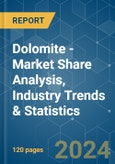The Dolomite Market size is estimated at 183.98 Million tons in 2024, and is expected to reach 224.06 Million tons by 2029, growing at a CAGR of 4.02% during the forecast period (2024-2029).
The market was negatively impacted by the COVID-19 pandemic in 2020 as there was a slowdown in production and mobility, wherein industries such as cement, ceramics, etc., were forced to delay their production due to containment measures and economic disruptions. Currently, the market has recovered from the pandemic. The market reached pre-pandemic levels in 2022 and is expected to grow steadily in the future.
This product will be delivered within 2 business days.
The market was negatively impacted by the COVID-19 pandemic in 2020 as there was a slowdown in production and mobility, wherein industries such as cement, ceramics, etc., were forced to delay their production due to containment measures and economic disruptions. Currently, the market has recovered from the pandemic. The market reached pre-pandemic levels in 2022 and is expected to grow steadily in the future.
Key Highlights
- The increasing applications in construction industries and expanding steel production in the Asia-Pacific region have been driving the market growth.
- However, the substitution of raw dolomites with igneous rock containing olivine minerals may hamper the demand for the studied market.
- Furthermore, the use of dolomite as a calcium and magnesium supplement is predicted to generate a market opportunity in the pharmaceutical industry.
- Asia-Pacific region dominated the market demand around the world, with countries like China, India, and Japan, being the biggest consumers.
Dolomite Market Trends
Increasing Demand from Construction Industry
- Dolomite is used as aggregate in Portland cement concrete, which is used for roads, buildings, and other structures. Dolomite is also used in combination with bituminous materials for roads and similar construction. Dolomite ground finds a huge application in the iron and steel industry due to its strength and compatibility in the process of purifying iron and steel.
- In the production of cement, dolomite is calcined, and then it is cut into blocks of a specific size. The construction industry is one of the largest consumers of cement. The growing commercial and industrial construction activities are experiencing a boom globally.
- According to the U.S. Census Bureau, the construction spending over the first 9 months of 2023 increased by about 4.6% to USD 1.46 trillion, compared to the same period in 2022.
- The construction sector in the Asia-Pacific region is the largest in the world, and the highest growth for housing is expected to be registered in the Asia-Pacific region, owing to the expanding housing construction markets in China and India.
- According to the National Bureau of Statistics of China, the domestic construction output peaked in 2022 at a value of about USD 4.11 trillion.
- Furthermore, India is expanding its commercial sector. Several projects have been going on in the country. For instance, the CommerzIII Commercial Office Complex construction worth USD 900 million started in Q1 2022. The project involves the construction of a 43-story commercial office complex with a permissible floor area of 2,60,128 square meters in Goregaon, Mumbai. The project is expected to be completed in Q4 2027, thus benefitting the studied market simultaneously during the forecast period.
- Owing to the factors mentioned above, the consumption of dolomite is expected to rise at a healthy rate from the construction industry over the forecast period.
Asia-Pacific to Dominate the Market
- The Asia-Pacific region is expected to account for the largest share of the global dolomite market during the forecast period owing to expanding industrial sectors, such as construction and healthcare, in major countries such as China, India, Japan, etc.
- China hosts a vast construction sector, and the developments in the infrastructure and residential sectors in the past two years have supported the growth of the construction sector at large, both in terms of volume and value.
- China is the largest cement producer globally, and the demand for cement is constantly increasing, supported by the rapidly growing construction industry. For instance, according to the National Bureau of Statistics (NBS) of China, cement output in the first half of 2023 increased to 980 million metric tons from 979 million metric tons in the same period in 2022, thus supporting the growth of the market.
- Also, according to the National Bureau of Statistics of China, the construction industry in China generated an added value of approximately CNY 8.3 trillion (~ USD 1.23 trillion) in 2022, reflecting an increase of more than 3% compared to the previous year.
- Also, the expanding healthcare sector is expected to fuel the market's growth. For instance, India is a global pharmaceutical hub, according to IBEF, the Indian Pharmaceutical industry is the third largest in the world in terms of volume and 14th largest in terms of value. The Indian Pharma sector contributes to nearly 1.72% of the country’s GDP.
- Therefore, owing to such trends mentioned above, the Asia-Pacific region is expected to dominate the dolomite market during the forecast period.
Dolomite Industry Overview
The dolomite market is partially fragmented in nature. The major players in the studied market (not in any particular order) include Sibelco, Calcinor, RHI Magnesita, JFE Mineral & Alloy Company, Ltd., and Dillon, among others.Additional Benefits:
- The market estimate (ME) sheet in Excel format
- 3 months of analyst support
This product will be delivered within 2 business days.
Table of Contents
1 INTRODUCTION
4 MARKET DYNAMICS
5 MARKET SEGMENTATION (Market Size in Volume)
6 COMPETITIVE LANDSCAPE
7 MARKET OPPORTUNITIES AND FUTURE TRENDS
Companies Mentioned (Partial List)
A selection of companies mentioned in this report includes, but is not limited to:
- Calcinor
- Carmeuse
- Dillon
- Imerys
- JFE Mineral & Alloy Company,Ltd.
- Lhoist
- Omya AG
- Rawedge
- RHI Magnesita GmbH
- Sibelco
Methodology

LOADING...










